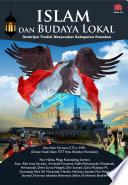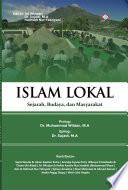Judul : ISLAM DAN BUDAYA LOKAL Deskripsi Tradisi Masyarakat Kabupaten Nunukan Penulis : Eko Nani Fitriono, S.Th.I., M.P.I., Nur Halisa, Mega Kaswajeng, Satriani, Ana, Ade Irma Suryani, Arminda Purnama, Fadhil Edryansyah, Mustainah, Armansyah, Dewi Surya Ningsih, Dini Suryani, Gina Musliyati M., Gunatang, Nira Siti Nurazizah, Hardin, Hariyani, Jumiati, Nur Anisa, Suryani, Nurman Iskandar, Rahmania Safitri, Nurfitriani Ibrahim Ukuran : 15,5 x 23 cm Tebal : 145 Halaman No ISBN : 978-623-6233-73-3 Kabupaten Nunukan terletak di perbatasan paling utara Indonesia. Daerah ini berbatasan langsung dengan Negara Malaysia. Sebagai tempat transit, Kabupaten Nunukan dihuni oleh penduduk asli dan pendatang yang datang dari berbagai pulau yang ada di Indonesia, seperti pulau Jawa dan Sulawesi, maka tidak heran dari masyarakat yang heterogen tersebut lahirnya budaya yang beragam. Berbagai tradisi dan budaya masyarakat Nunukan, mulai dari tradisi yang berkaitan dengan etika, pernikahan, akulturasi budaya lokal dan Islam, serta ritual lainnya yang dipaparkan dalam bingkai Islam dapat pembaca temukan dalam buku ini. Buku kolaborasi tulisan dosen dan mahasiswa STIT Ibnu Khaldun Nunukan ini menjadi tulisan yang menarik untuk dibaca dalam upaya memahami budaya yang hidup dan berkembang di Kabupaten Nunukan dengan berbagai latar belakang masyarakatnya yang heterogen.
-
ISBN 13 : 623623373X
-
ISBN 10 : 9786236233733
-
Judul : ISLAM DAN BUDAYA LOKAL Deskripsi Tradisi Masyarakat Kabupaten Nunukan
-
Pengarang :
dkk,
Eko Nani Fitriono,
S.Th.I.,
M.P.I,
Nur Halisa,
Mega Kaswajeng,
S.Th.I.,
M.P.I,
Nur Halisa,
Mega Kaswajeng,
-
Kategori : Religion
-
Penerbit : Penerbit Adab
-
Bahasa : id
-
Tahun : 2021
-
Halaman : 145
-
Google Book : https://play.google.com/store/books/details?id=0l5BEAAAQBAJ&source=gbs_api
-
Ketersediaan :
| 008411 |
Tersedia di Library of UI BBC
|
Judul : ISLAM DAN BUDAYA LOKAL Deskripsi Tradisi Masyarakat Kabupaten Nunukan Penulis : Eko Nani Fitriono, S.Th.I., M.P.I., Nur Halisa, Mega Kaswajeng, Satriani, Ana, Ade Irma Suryani, Arminda Purnama, Fadhil Edryansyah, Mustainah, ...










